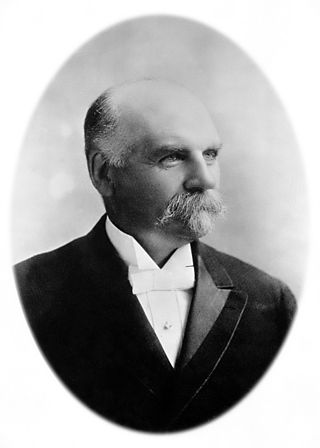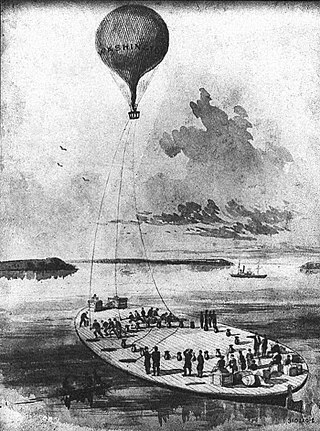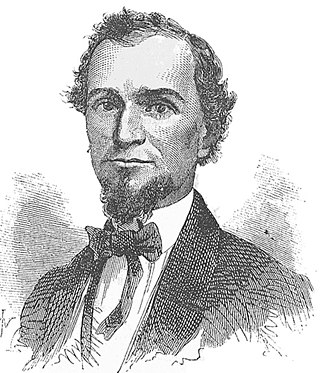
A blimp, or non-rigid airship, is an airship (dirigible) without an internal structural framework or a keel. Unlike semi-rigid and rigid airships, blimps rely on the pressure of the lifting gas inside the envelope and the strength of the envelope itself to maintain their shape.

An airship or dirigible balloon is a type of aerostat or lighter-than-air aircraft that can navigate through the air under its own power. Aerostats gain their lift from a lifting gas that is less dense than the surrounding air.

Joseph Henry was an American scientist who served as the first Secretary of the Smithsonian Institution. He was the secretary for the National Institute for the Promotion of Science, a precursor of the Smithsonian Institution. He was highly regarded during his lifetime. While building electromagnets, Henry discovered the electromagnetic phenomenon of self-inductance. He also discovered mutual inductance independently of Michael Faraday, though Faraday was the first to make the discovery and publish his results. Henry developed the electromagnet into a practical device. He invented a precursor to the electric doorbell and electric relay (1835). His work on the electromagnetic relay was the basis of the practical electrical telegraph, invented separately by Samuel F. B. Morse and Sir Charles Wheatstone. In his honor, the SI unit of inductance is named the henry.
A transatlantic flight is the flight of an aircraft across the Atlantic Ocean from Europe, Africa, South Asia, or the Middle East to North America, Latin America, or vice versa. Such flights have been made by fixed-wing aircraft, airships, balloons and other aircraft.
This is a list of aviation-related events during the 19th century :

High-altitude balloons or stratostats are crewed or uncrewed balloons, usually filled with helium or hydrogen, that are released into the stratosphere, generally attaining between 18 and 37 km above sea level. In 2002, a balloon named BU60-1 reached a record altitude of 53.0 km.

A gas balloon is a balloon that rises and floats in the air because it is filled with a gas lighter than air. When not in flight, it is tethered to prevent it from flying away and is sealed at the bottom to prevent the escape of gas. A gas balloon may also be called a Charlière for its inventor, the Frenchman Jacques Charles. Today, familiar gas balloons include large blimps and small latex party balloons. For nearly 200 years, well into the 20th century, manned balloon flight utilized gas balloons before hot-air balloons became dominant. Without power, heat or fuel, untethered flights of gas balloons depended on the skill of the pilot. Gas balloons have greater lift for a given volume, so they do not need to be so large, and they can stay up for much longer than hot air balloons.

Thaddeus Sobieski Constantine Lowe, also known as Professor T. S. C. Lowe, was an American Civil War aeronaut, scientist and inventor, mostly self-educated in the fields of chemistry, meteorology, and aeronautics, and the father of military aerial reconnaissance in the United States. By the late 1850s he was well known for his advanced theories in the meteorological sciences as well as his balloon building. Among his aspirations were plans for a transatlantic flight.

The Union Army Balloon Corps was a branch of the Union Army during the American Civil War, established by presidential appointee Thaddeus S. C. Lowe. It was organized as a civilian operation, which employed a group of prominent American aeronauts and seven specially built, gas-filled balloons to perform aerial reconnaissance on the Confederate States Army.

Balloons were one of the first mechanisms used in air warfare. Their role was originally mainly for reconnaissance purposes. They provided humans with the first available method of elevating themselves well over the battlefield to obtain the proverbial "birds-eye view." They were an early instrument of definitive intelligence collection and were also particularly useful in the preparation of accurate battlefield maps, before which time this rudimentary craft had led to many a battlefield failure. Incendiary balloons also have a long history. The incendiary balloons carry hot air or something that can catch fire to destroy enemy territory. They could also hold small bombs for combat. The history of military ballooning dates back to the late 18th century, when the Montgolfier brothers, Joseph-Michel and Jacques-Étienne, first demonstrated the potential of hot-air balloons for military use. The first recorded military use of balloons was during the French Revolutionary Wars, when the French military used balloons to gather intelligence on the movements of the enemy. Balloons were also used during the American Civil War, where they were used for reconnaissance and communication.

A balloon carrier or balloon tender was a ship equipped with a balloon, usually tied to the ship by a rope or cable, and usually used for observation. During the second half of the 19th century and the early 20th century, these ships were built to have the furthest possible view of the surrounding waters. After several experiments, the type became formalized in the early 1900s, but was soon to be superseded by the development of seaplane carriers and regular aircraft carriers at the beginning of World War I.

Naval Air Station Rockaway adjoined Fort Tilden on the western portion of the Rockaway Peninsula in the New York City borough of Queens. It was established on transferred municipal property in 1917 during American involvement in World War I.

John Wise was a pioneer in the field of ballooning. He made over 400 flights during his lifetime and was responsible for several innovations in balloon design. His balloon, The Jupiter carried 123 letters to make the first official airmail delivery run for the US Post Office in 1859.

Beginning in 1908 and lasting until 1937, the U.S. Army established a program to operate airships. With the exceptions of the Italian-built Roma and the Goodyear RS-1, which were both semi-rigid, all Army airships were non-rigid blimps. These airships were used primarily for search and patrol operations in support of coastal fortifications and border patrol. During the 1920s, the Army operated many more blimps than the U.S. Navy. They were also used because they were not seen as "threats" on the battlefield by opposing forces, unlike airplanes, due to their passive role in combat.

Fort Corcoran was a wood-and-earthwork fortification constructed by the Union Army in northern Virginia as part of the defenses of Washington, D.C. during the American Civil War. Built in 1861, shortly after the occupation of Arlington, Virginia by Union forces, it protected the southern end of the Aqueduct Bridge and overlooked the Potomac River and Theodore Roosevelt Island, known as Mason's Island.

USS George Washington Parke Custis was a barge acquired by the Union Navy during the American Civil War for use as a balloon-launching platform to spy on Confederate defenses from afar.

The history of ballooning, both with hot air and gas, spans many centuries. It includes many firsts, including the first human flight, first flight across the English Channel, first flight in North America, and first aircraft related disaster.

Taylor's Tavern was a significant outpost for Union Forces during the US Civil War. It was among the first locations in Virginia where the two opposing sides came into contact. The tavern was probably built about 1800 near the site of an old Indian trading post at Seven Corners.

John LaMountain was a ballooning pioneer. He was privately contracted as an aerial observer by General Butler at Fort Monroe during the American Civil War and is accredited with having made the first report of useful intelligence on enemy activity. Afterwards he worked a short assignment with the Union Army Balloon Corps.

The United States capital, Washington, D.C., has been the site of several events in the nation's history of aviation, beginning from the time of the American Civil War, often for the purpose of promoting the adoption of new aeronautical technologies by the government. It has also been home to several aircraft manufacturers and aviation organizations, and many aerospace contractors have maintained a presence there as well.

















